A classic Chinese Buddhist dish upgraded to the holiday version. This vegetarian roast duck is a perfect holiday loaf for both vegetarian and vegan feasts. {Vegan, Gluten-Free adaptable}

Seasoned veggies are cooked and wrapped in yuba sheets, steamed then fried until tender inside and crispy on the outside, then served with a savory sauce. It has a meaty texture on the outside and a dumpling-like filling on the inside. Compared to a traditional holiday loaf that is usually made with seitan and has a homogeneous texture, this one is so much more fun to eat, more delicious, and more nutritious.
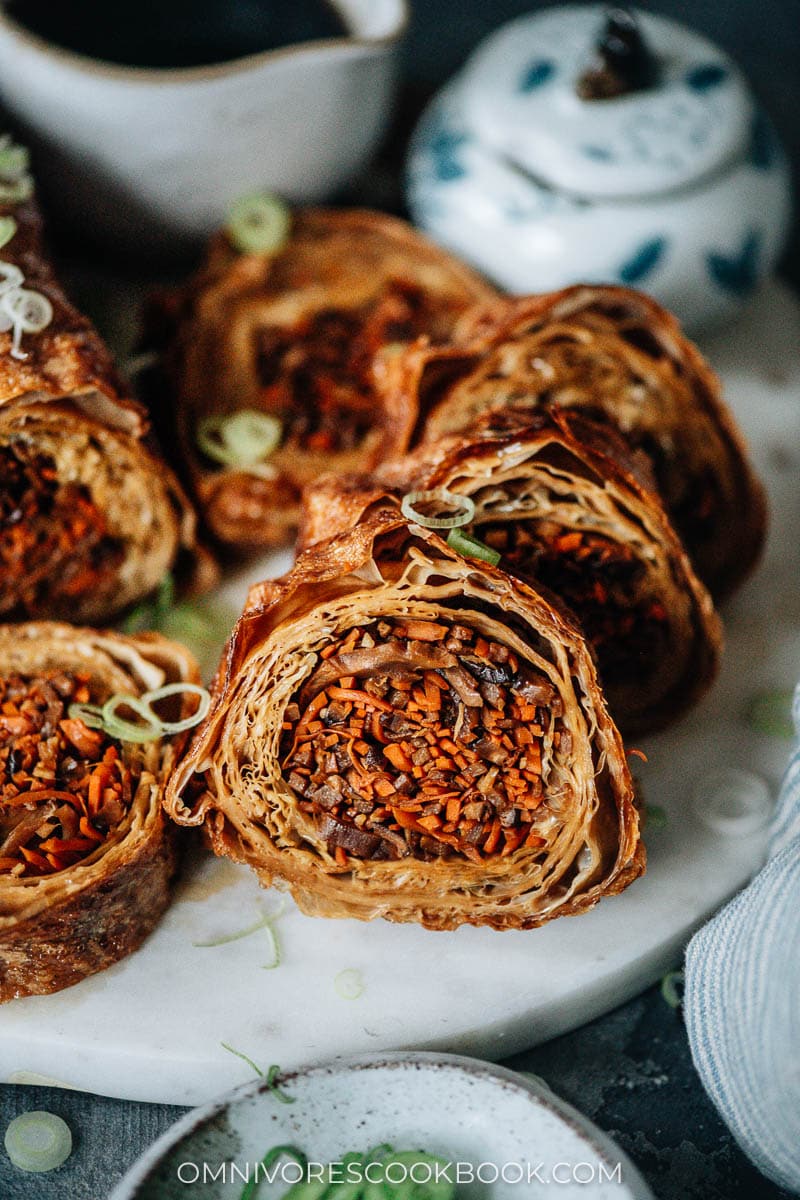
Background
Chinese Buddhist cuisine is famous for making mock meat and using various natural ingredients to mimic meat dishes. Despite the fact that vegan meat is gaining popularity worldwide these days, Chinese cuisine started centuries ago (for further reading, refer to this interesting article on Vice).
One of the most commonly used ingredients to produce mock meat is soybeans. Not limited to tofu (or fried tofu), you will find soybeans in various forms in a Chinese market. Among them, one of my favorite products is yuba, or dried tofu skin (豆皮), or bean curd sheet, or tofu sheet. It’s the key ingredient to making vegetarian roast duck (or goose).
What is dried yuba
Yuba is a by-product of making soy milk. If you’ve ever made soy milk at home, you’d notice a thin layer of film appears on top of the milk if slightly chilled. That is yuba in its wet form. Once dried, it will become a paper-thin semi-transparent firm-ish sheet that can be folded and stored for a longer period of time.

There are many ways to use dried yuba. You can simply cut it and add it to the soup (or hot pot). It will be fully rehydrated and cooked within seconds, and generate a tender yet meaty texture. Compared to tofu, yuba cooks faster, absorbs flavor better, and has a more meat-like mouthfeel. One of our dinner staples is veggie miso soup (especially after my husband converted to plant-based). And I always enjoy adding some cut-up yuba strips to the soup to add an egg-like texture.
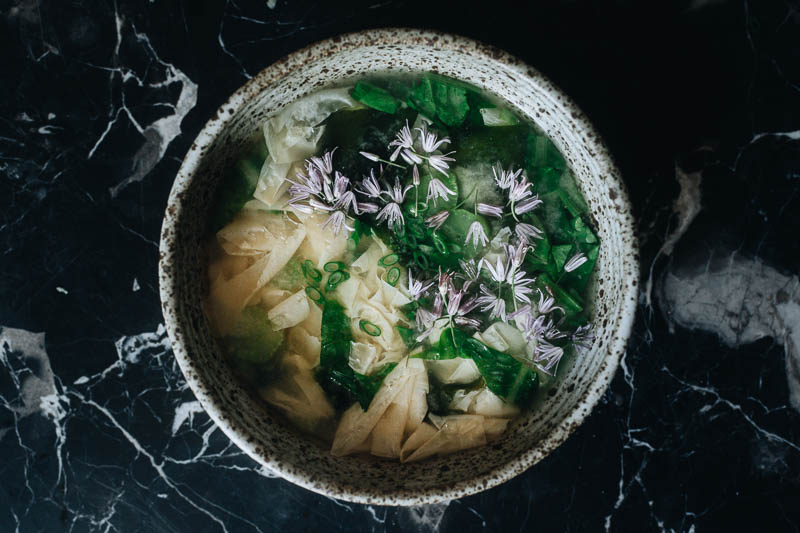
Make mock meat using yuba
If you’ve ever been to a vegan Chinese restaurant (my favorite is Buddha Bodai in Manhattan Chinatown) or even a regular Chinese restaurant, you can usually find vegetarian duck or goose made with folded yuba sheets and sometimes stuffed with veggie filling. It’s a traditional Shanghai dish that is usually served as an appetizer.
Because of yuba’s special texture, when folded and cooked, it will yield a texture that is similar to poultry skin. It’s a bit chewy on the inside, crispy on the outside, and full of flavor.
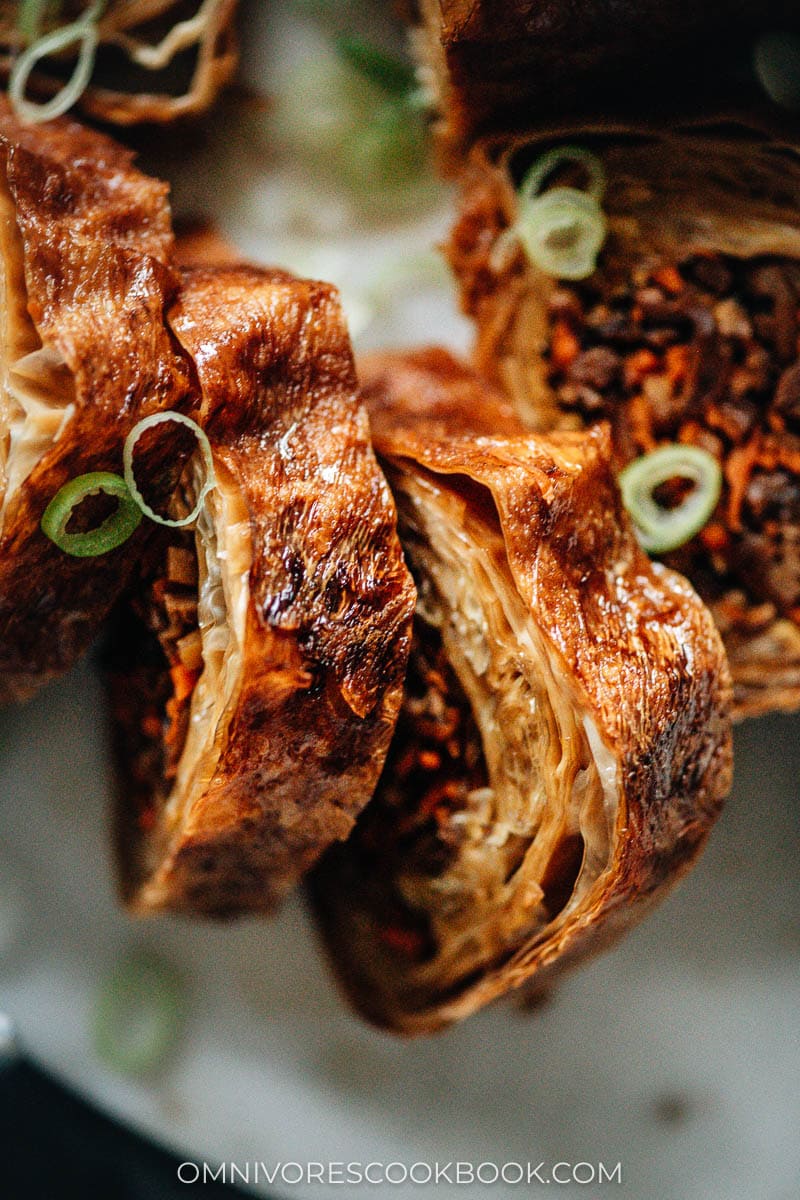
Vegan loaf inspired by a traditional vegetarian roast duck
Traditional vegetarian roast duck is usually a small dish and served as an appetizer. When I read the recipe from Land of Fish and Rice: Recipes from the Culinary Heart of China by Fuchsia Dunlop, I was intrigued by her folding method. It is not the easiest recipe but it makes a much bigger loaf, which seems perfect to serve as a centerpiece during the holiday season for a vegan / vegetarian themed party.
After many rounds of testing, we changed up the recipe by using more vegetable filling with slightly different ingredients. It makes a bigger loaf, better texture and a more balanced taste.
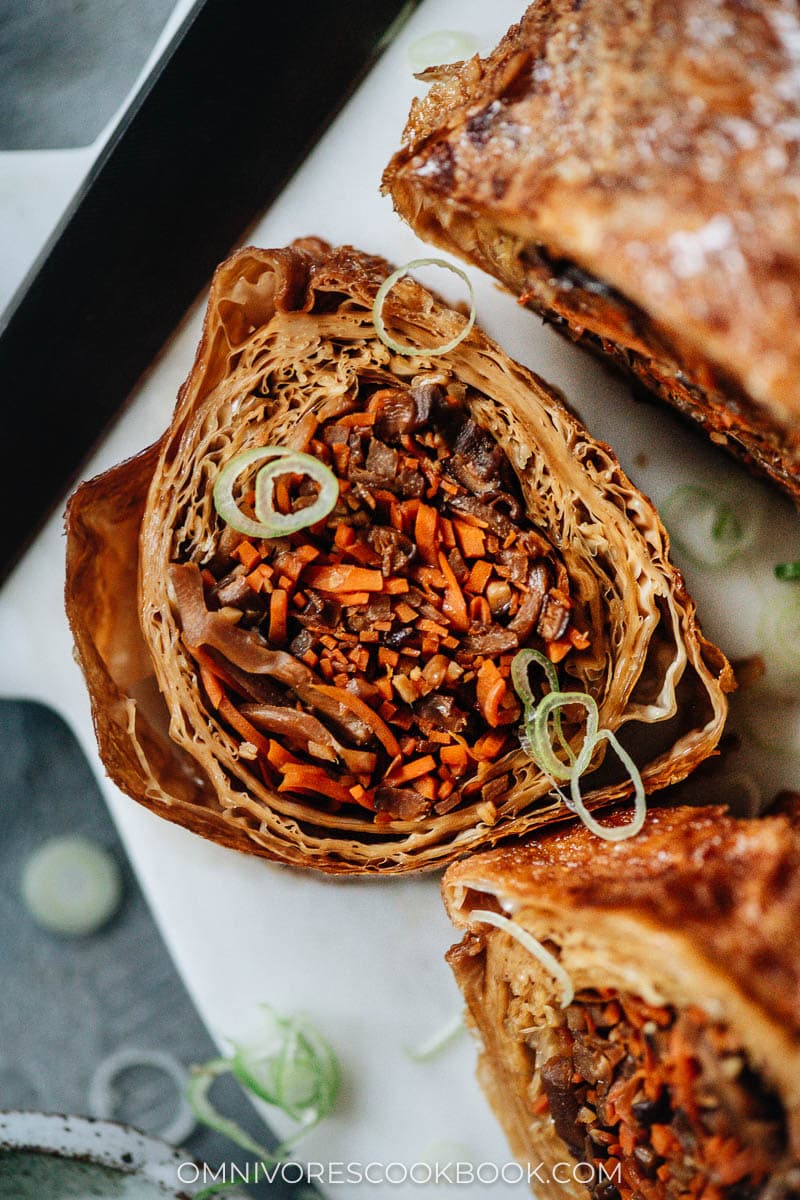
Shop for yuba
You can usually find two types – the round shape (image on the left) and the square shape (image on the right). The brand on the right is my favorite because it does not contain preservatives and tastes slightly better.
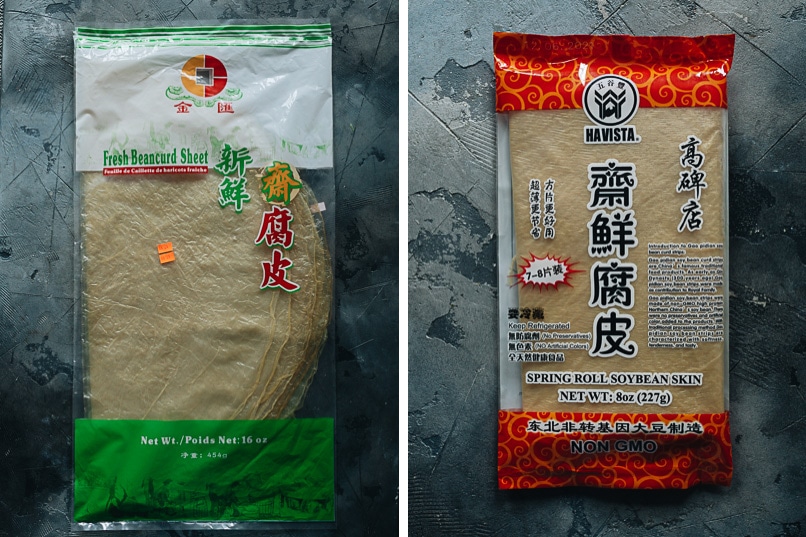
You will need to run to an Asian market to get yuba, usually in the freezer or refrigerator section. You can also find the round type on Amazon.
This recipe uses the round type, but you can also use the square one as well.
Cooking process
Making the vegetarian roast duck definitely requires some time and effort, but the end result is totally worth it.
Part 1 – prepare the filling
You will need to slice the carrots and bamboo shoots into strips. For an easier and faster process, you can use a julienne peeler for the carrot.

Once prepped, you will need to cook the filling by:
- Sauteing the aromatics
- Stir frying the veggies until just tender
- Mixing in the sauce, then
- Cooking until the veggies are tender but not mushy
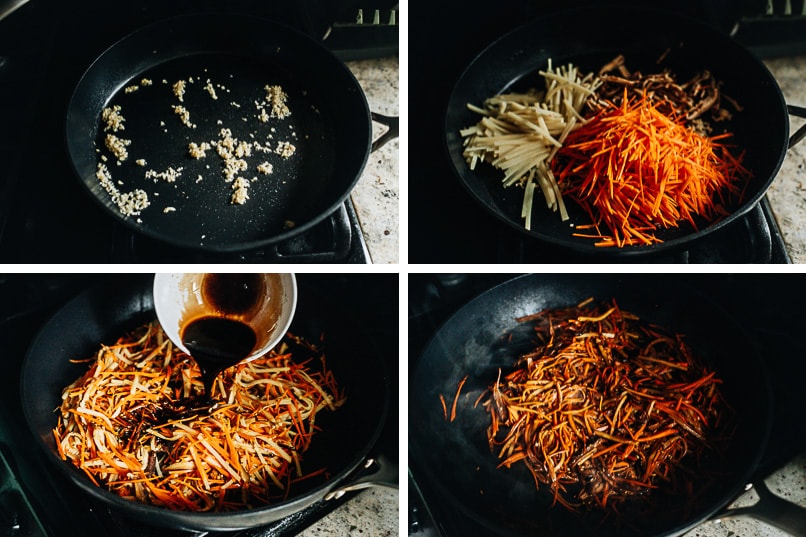
Part 2 – Prepare the yuba sheets
- Take out the yuba sheets you need, stack them and fold them into half moons. Cut off the tough edges
- Stick the cut-off edges into the sauce (you will use the cut-off edges as a brush later, then as part of the filling)
- Cut the round sheet into halves
Note: if you’re using the square yuba, you can simply cut it into two big rectangles.
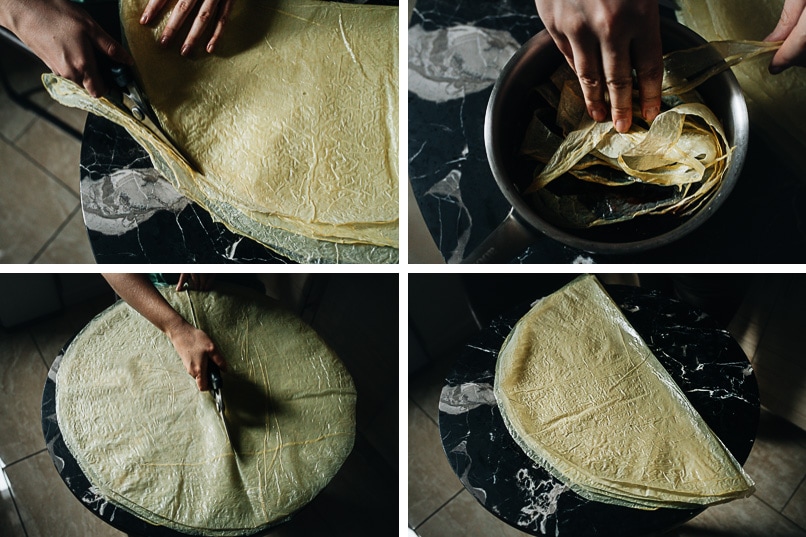
Part 3 – Assemble and cooking
- Lay one sheet of yuba on a big working surface. Brush with the sauce using the cut-off yuba edges
- Top with another sheet of yuba, but place it in the opposite orientation so it forms a big rectangle-like shape. Generously brush with the sauce again. Repeat until you’ve used all the prepared sheets
- Place the cut-off yuba onto the layers
- Top with the vegetable filling. Note, it’s important to keep the filling in a short-ish shape just so you will be able to fit the loaf in a steamer and a frying pan later
- Roll of the bottom end of the sheets to cover the filling
- Wrap up both sides of the sheets
- Continue rolling up the sheet until it forms a loaf
- Place the loaf seam side down into a prepared steamer. Steam for 8 minutes
- Heat up enough oil to cover half of the loaf
- Fry the loaf until all sides turn golden brown
- Drizzle the sauce right before serving
- Carve and serve!
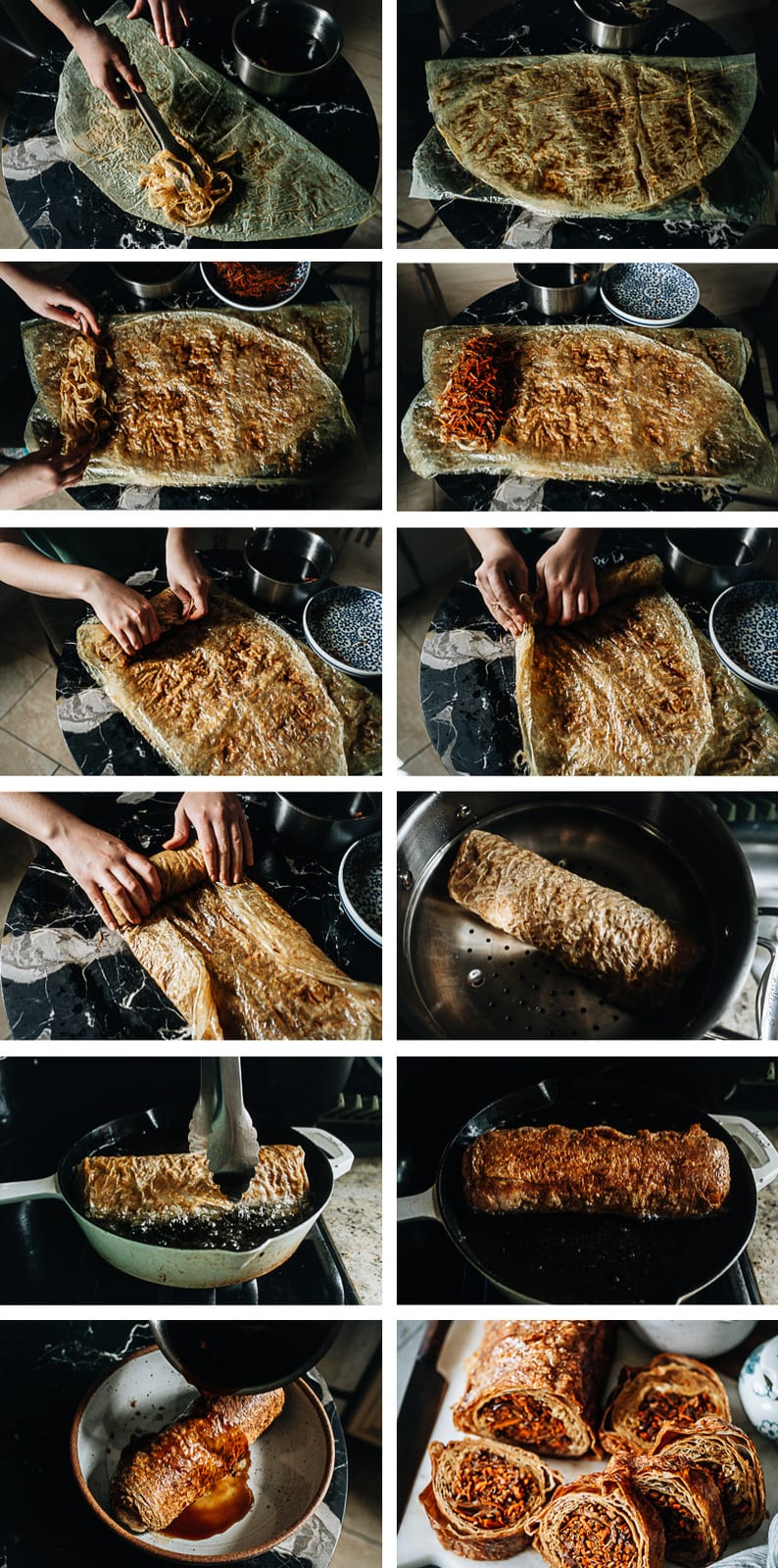
A word on the cookware
It’s best to find a tall pan (e.g a large dutch oven) that just fits the loaf for the frying process, to prevent the oil from splattering and to minimize oil usage. That’s why it’s important to measure the loaf while folding it, to make sure that it can fit into your pan.
Once you’re done cooking, you should serve the vegetarian roast duck as soon as possible to maximize texture and mouthfeel. After you pour over the sauce, the “duck skin” will not remain super crispy but it will still have a nice chewy texture. The filling is rich and crunchy, paired perfectly with the meaty skin.
Afterthought
I admit this is a relatively complicated recipe and it’s definitely for special occasions. But once you’ve tried it, I guarantee you that it’s so much better than the typical seitan holiday loaf that is rubbery and plain.
The shallow frying is not the easiest step, but it’s important to do it so the layers of skin will puff up and create a better texture.
If you’re feeling adventurous, you can totally use the same ingredients to make a smaller vegetarian roast duck (the regular size served at Chinese restaurants). You will need to use half of the filling and half of the sheets to make two individual parcels, and reduce the cooking time by two thirds. It will make the cooking process much easier.
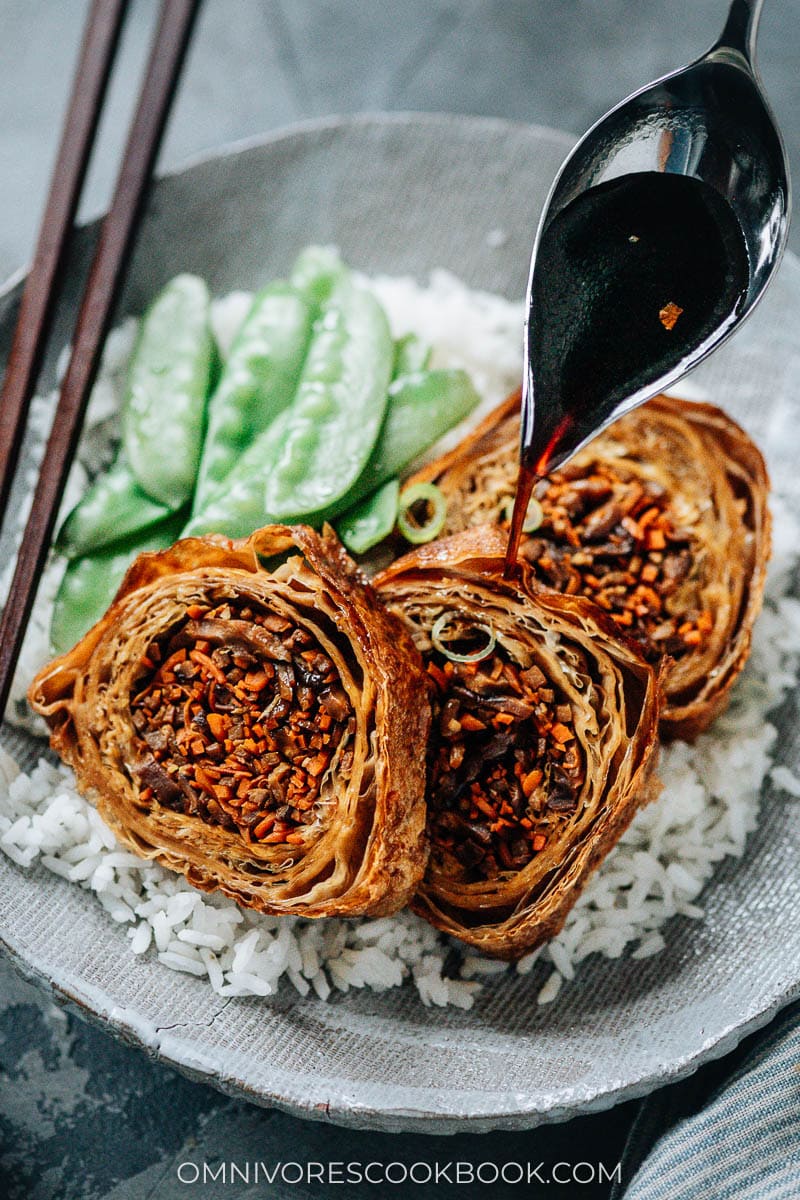
More delicious vegan holiday recipes
- Kung Pao Cauliflower
- Eight Treasure Rice (八宝饭, Chinese Rice Pudding)
- Crispy Marinated Tofu
- Curried Vegan Green Bean Casserole
- Homemade Vegan Dumplings (素菜锅贴)
- Vegan Mango Pudding
Want to learn more about Chinese Cooking? Sign up my newsletter to receive the 5-Day Chinese Cooking Crash Course and recipe update!
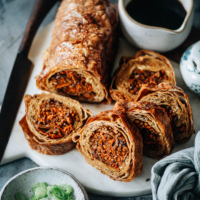
Vegetarian Duck (素鸭) Vegan Holiday Loaf
Ingredients
Broth
- 1 ” (2.5 cm) ginger , sliced
- 1 star anise pod
- 2 tablespoons sugar
- 2 tablespoons Shaoxing wine (or dry sherry)
- 2 tablespoons light soy sauce
- 2 teaspoons dark soy sauce
- 1 teaspoon sesame oil
- 1 1/2 cup water
Filling
- 1 (3 oz / 85 g) carrot , shredded
- 1/2 can (3 oz / 85 g) bamboo shoots , shredded
- 1 tablespoon Vegetable oil for frying
- 1 ” (2.5 cm) ginger , minced
Filling sauce
- 1 tablespoon Shaoxing wine
- 1 teaspoon light soy sauce
- 1 teaspoon dark soy sauce
- 1 teaspoon sugar
Wrapping
- 3 sheets tofu sheet (dried yuba)
- 2 cups oil , for frying
Instructions
- Gently rinse the dried shiitake mushrooms with tap water to remove any dust. Add the mushrooms into a medium-sized bowl and add 1/2 cup boiling water to cover. Make sure the mushrooms are submerged. Let rehydrate until the mushrooms turn soft, 15 to 20 minutes. Cut and prepare the other ingredients in the meantime. Once the mushrooms are done soaking, squeeze out the excess liquid and slice into strips. Reserve the soaking liquid.
Boil and cool the broth
- Combine all the broth ingredients plus 3 tablespoons of mushroom soaking liquid in a small pot. Bring to a boil over medium-high heat and stir to dissolve the sugar. Remove the pot from the heat and set aside to cool completely.
Prepare the filling
- Mix the filling sauce ingredients with 1 tablespoon of the mushroom soaking liquid in a small bowl. Stir to mix well.
- Heat oil in a skillet over medium heat until hot. Add the ginger and stir for 30 seconds, until it smells fragrant.
- Add the rehydrated sliced shiitakes, carrots, and bamboo shoots. Cook and stir for another minute.
- Pour in the sauce. Cook and stir until it is absorbed into the vegetables and the carrots are softened, 1 to 2 minutes. Transfer everything to a big plate and set aside.
Assemble the loaf
- Remove the tofu sheet from the package, remove 3 sheets from the stack, and keep them stacked and folded in half. Using a pair of kitchen shears, cut the uneven hard edges from the tofu sheets, and place the cut-off edges into the broth. Then slice the sheets in half so that you have 6 semi-circles.
- Lay one semi-circle on a large clean work surface, so that the straight edge is facing left. Gather the cut edges from the broth with a pair of tongs. Use them to wipe a generous layer of broth onto the tofu sheet (it will be absorbed by the tofu), returning the edges to the broth when you are done. Lay another semi-circle over the first, this time with its straight edge facing right so that a rectangle-like shape is formed. Wipe the top layer of the tofu sheet with the broth in the same way you did with the previous layer. Repeat these steps, switching between laying the sheet right or left, until all the semi-circles are used. (See the blog post above for the step-by-step pictures.)
- Squeeze most of the broth out of the edges and place them at the base (closest to you) of the rectangle, leaving 2” (5 cm) at the bottom and to both sides. Layer all the vegetable filling over the edges. When you’re doing this step, it’s important to make sure the length of the filling is shorter than the frying pan you will use later for the frying. (*Footnote 1)
- Starting from the bottom, roll the sheets over the filling. Squeeze and tuck it tightly and continue to roll until the filling is fully covered. Then fold both sides inwards. Continue to roll so that they are tucked in. Once done, place the roll seam side down and you will have a loaf.
Cook the loaf
- Prepare a steamer by adding water and bringing it to a boil. Place the loaf on the steaming rack. Steam covered for 8 minutes over high or medium-high heat. Once done, carefully remove the loaf from the steamer. Place it on a rack to let it drain.
- Prepare a plate or a tray and top it with a wire rack.
- Prepare a high-walled pan or pot that is large enough to fit the roll. Add enough oil so it would cover half of the loaf (but don’t put the loaf in yet). Heat over medium heat until it reaches 350°F (176°C). Gently lower the roll in with the seam side down. You can do this using a pair of tongs with the help of a spatula. Fry 2 to 3 minutes per side, until the roll turns golden brown all over. Carefully remove the loaf from the oil onto a rack to let drain briefly. Then transfer to a high-walled dish. Let rest for 5 minutes.
- Before serving, drizzle the remaining broth over the roll.
- Serve the dish hot or warm as a main dish.
Notes
- I highly recommend using a tall pan or dutch oven to fry the loaf. If you plan to use a dutch oven for this step, you need to make sure the loaf can fit into it because their bottom might be quite small.
Nutrition
If you give this recipe a try, let us know! Leave a comment, rate it (once you’ve tried it), and take a picture and tag it @omnivorescookbook on Instagram! I’d love to see what you come up with.
More vegan recipes
- Home Style Tofu (家常豆腐)
- Chinese Scallion Pancakes (葱油饼)
- Bok Choy Soup
- Chinese Pickled Cucumber (A Quick Pickle Recipe)
- Instant Pot Lentil Soup (Chinese Style)
Lilja Walter is a part of the Omnivore’s Cookbook team and worked closely with Maggie to develop and test this recipe.













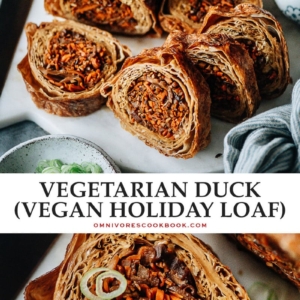
“Yuba is a by-product of making soy sauce.”
Did you perhaps mean to write soy MILK?
Thanks for the correction!
My mouth is watering. My Taiwanese grandma makes rolls like these with the crispy skin. Makes me miss having family style dinners in her kitchen. I might have to try making them myself. Thank you for sharing.
I used to live in Taiwan…I ate tofu skin with basil…sooooo good!
Is it possible to make this with dried Yuba?
This is made with the dried yuba sheet.
Oh I thought it said it said frozen 😅
Yes the frozen ones will work!
I’ve learned so much from you and regularly make your recipes some of which have become firm favourites. When I managed to get the bean curd sheets I set about this rather complex recipe with enthusiasm. The end result looked similar to your pictures and my wife and I sat down to our dinner with great hopes. Unfortunately neither of us could get past the first mouthful. The filling with it’s sauce was OK but the yuba/bean curd “skin” was one of the most unpleasant things we’ve ever been unfortunate enough to taste. Sorry but this one is definitely not for us.
I recently posted a comment for this recipe but it no longer appears. Does this mean you have deleted it?
Hi Peter, I did not delete the comment. My website is under maintenance due to a server issue and some of the comments might not be visible before the database is fully restored. If you check back a few days later you should be able to view your comment. Apologize for the confusion. Hope you have a great day and Happy New Year!
Hey, I tried the recipe and I love it! I have my own version I got from this book.
https://tinyurl.com/PlantBasedCookbk
Try it and let me know what you think.